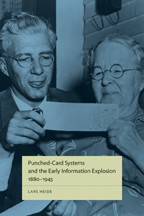At a time when Internet use is closely tracked and social networking sites supply data for targeted advertising, Lars Heide presents the first academic study of the invention that fueled today’s information revolution: the punched card.
Early punched cards helped to process the United States census in 1890. They soon proved useful in calculating invoices and issuing pay slips. As demand for more sophisticated systems and reading machines increased in both the United States and Europe, punched cards served ever-larger data-processing purposes. Insurance companies, public utilities, businesses...
At a time when Internet use is closely tracked and social networking sites supply data for targeted advertising, Lars Heide presents the first academic study of the invention that fueled today’s information revolution: the punched card.
Early punched cards helped to process the United States census in 1890. They soon proved useful in calculating invoices and issuing pay slips. As demand for more sophisticated systems and reading machines increased in both the United States and Europe, punched cards served ever-larger data-processing purposes. Insurance companies, public utilities, businesses, and governments all used them to keep detailed records of their customers, competitors, employees, citizens, and enemies.
The United States used punched-card registers in the late 1930s to pay roughly 21 million Americans their Social Security pensions, Vichy France used similar technologies in an attempt to mobilize an army against the occupying German forces, and the Germans in 1941 developed several punched-card registers to make the war effort—and surveillance of minorities—more effective. Heide’s analysis of these three major punched-card systems, as well as the impact of the invention on Great Britain, illustrates how different cultures collected personal and financial data and how they adapted to new technologies.
This comparative study will interest students and scholars from a wide range of disciplines, including the history of technology, computer science, business history, and management and organizational studies.







